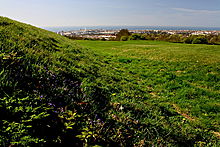|
|
|
|
Hollingbury HillfortHillfort
|
||||||||||||||||||||||||
|
|
|
Images (click to view fullsize) |
|


















|
Fieldnotes |
|
|
This roughly square hillfort encloses about 3.6 hectares and is defended by a single rampart and ditch with a counterscarp bank on its southern side. This fort gave it's name to a particular type of construction, whereby the rampart was built of 2 rows of posts 2 metres apart, tied together with cross beams to form a continuous box, and then filled with chalk rubble. On my visit today a large section of the interior has been freshly strimmed (much is still covered in thick gorse) and so gives a chance to have a better look at the disk barrows near the center. I have visited the larger one many times before, but two other smaller barrows are evident to the North of this one. There is an even smaller barrow to the West, but I didn't spot it. These (bronze age) barrows predate this sites defensive use. Someone had placed a small bunch of fresh flowers at the meeting of the paths that disect the interior of the fort. Those seeking a glimpse of the eternal and an escape from the modern bustle of Brighton can do no better than to climb the Ditchling Road to the stunning viewpoint of Hollingbury. Access: It's in the middle of a public golf course, several paths leading in from all directions. Bring your wits, or a cycling helmet! |
25th April 2005ce |
Folklore |
|
Hollingbury: hidden treasure, uncertain whether supposed to be concealed in the hill-fort or the barrows within it. See Sussex A. C. 75 (1934), 238.Barrow Treasure, in Fact, Tradition, and Legislation L. V. Grinsell Folklore, Vol. 78, No. 1. (Spring, 1967), pp. 1-38. |
 Posted by Rhiannon
Posted by Rhiannon21st March 2007ce |
Miscellaneous |
|
A few weeks since, a labourer employed in digging flints, near Hollingbury Castle (the ancient earthwork or camp on the summit of the hill between Brighton and Stanmer), discovered an interesting group of antiquities, placed very superficially in a slight excavation on the chalk rock. It consisted of a brass instrument, called a celt; a nearly circular ornament, spirally fluted, and having two rings placed loosely on the extremities, and four armillae or bracelets for the wrist, of a very peculiar shape. All these ornaments are composed of a metallic substance, which, from the appearance of those parts where the green patina, with which they are encrusted, has been removed, must have originally posessed a lustre but little inferior to burnished gold. They are clearly either of Roman or Anglo-Roman origin, and probably were buried on or near the site of interment of the individual to whom they belonged.From the Salisbury and Winchester Journal, 7th February 1825. It seems they're in the British Museum now: I found their photo here. Not quite so flash as a gold torc but I like them. They've got a very modern minimal look about them. |
 Posted by Rhiannon
Posted by Rhiannon19th December 2017ce Edited 19th December 2017ce |
|
Found this reference to stones at Hollingbury. "One word in conclusion, on those earthworks to which I have alluded as, in my opinion, possessing strong claims to be considered of Druidical origin. I refer to the earthworks of Cauburn (sic) and Whitehawk Hill. Others may have possessed similar pretensions, and more particularly Hollingbury, in the vallum and within the inclosure of which portions of Druidical stones are still to be found; and at the southern most of its two western portae, the remains of an upright stone of this kind still stands, projecting a little above the sod, precisely in the position of the two stones at Stonehenge. " from Turner, E. 1850 Military Earthworks of the South Downs with a more enlarged account of Cissbury, one of the principal of them. Sussex Archaeological Collections Volume 3: 173-184. Well I don't buy a megalithic monument at Hollingbury for a second but the presence of (presumably) sarsens stones on the hill is interesting. They could have naturally occurred there, the hill being capped with remnant Tertiary deposits, they could well have been included in the fabric of the hillfort. What is clear is that nothing remains of the stones now, unless some lie recumbant beneath the turf, a fact unlikely given the thin soil depth. As with the supposed megaliths at Church Hill and barrows at Whitehawk they remain a mystery, a part of Brighton's lost prehistory. |
Posted by Paravellean 5th May 2005ce Edited 5th May 2005ce |
Links |
|
Hollingbury Hillfort Home PageA great site (put together by a local) packed with interesting info on Hollingbury. |
25th April 2005ce |

